At first, when We Build The Wall hosted a flashy event on May 30, 2019 near the U.S.-Mexican border, the Department of Homeland Security had no interest in participating.
El Paso’s chief patrol agent Aaron Hull emailed a superior to flag the invitation he had received from Kris Kobach, the group’s general counsel, while clarifying that “We were not involved in any way in the effort.”
“We are declining this invitation,” Hull wrote. “However, I suspect that they will say that we helped/supported/whatever their effort in their press conference today.”
It would take only three months for the DHS to change its tune on the pro-Trump group, which had launched in 2018 to construct sections of border wall on private land with crowdsourced funding. That August, Mark Morgan, then the acting commissioner of U.S. Customs and Border Protection, hosted Kobach and two other emissaries from the group for a meeting in Washington with several other top CBP officials.
Morgan, according to an internal readout of the August 27, 2019 meeting, thanked We Build The Wall for the “positive interaction they have had with CBP.” He elaborated on the “enhanced safety” the group’s wall-building project provided CBP agents.
When the group asked about the possibility of constructing more border fence and then donating it to CBP, its deputy commissioner, Robert Perez, “expressed that CBP is interested in exploring all available options if an offer were made,” according to the summary.
Kobach and his associates were sent on their way with several pages of instructions on how to submit such a “donation” proposal and with a promise that CBP would be back in touch in a few weeks, according to the internal account of the meeting.
The readout was among hundreds of pages of documents TPM obtained Monday through a Freedom of Information Act request laying out the extent to which, in 2019 and early 2020, Trump’s DHS welcomed We Build The Wall’s offer to privately finance construction of a border wall. Trump himself was struggling to fund his own oft-promised expanded border wall through government appropriations, and there was no hope that, as Trump claimed on the 2016 campaign trail, Mexico would pay for it.
The gambit, despite DHS’ encouragement, did not get very far, and came crashing to a halt last August when several people involved with We Build The Wall — including former Trump advisor Steve Bannon — were charged by a federal grand jury for allegedly defrauded the group’s donors. (Kobach himself was not among those indicted and has not been accused of any illegal activity.)
When the charging documents were unsealed, DHS tried to distance itself from the effort, with then acting DHS Secretary Chad Wolf claiming that he never endorsed their gambit.
But at least through fall of 2019 and into that winter, top officials at the CBP were in regular contact with Kobach as they walked him through the process of offering the construction of a section of border wall as a donation to DHS. Once that donation was formally proposed in Feb. 2020, at least some agency officials had given the proposal their informal approval.
Much of this back-and-forth occurred while the federal investigation into We Build The Wall’s fundraising tactics was well underway — and even after some involved in the group were allegedly told that their conduct was being probed by federal investigators.
A ‘Positive Operational Impact’
The lack of interest Agent Hull expressed in May 2019 in participating in We Build The Wall’s endeavor was not shared — at least, not for long — among colleagues at the Department of Homeland Secretary.
Just a week after the May 30 event, Kobach managed to pique the interest of then-acting DHS Secretary Kevin McAleenan. Kobach sent McAleenan a letter requesting permission, on behalf of We Build The Wall, to build border fencing at a site in New Mexico.
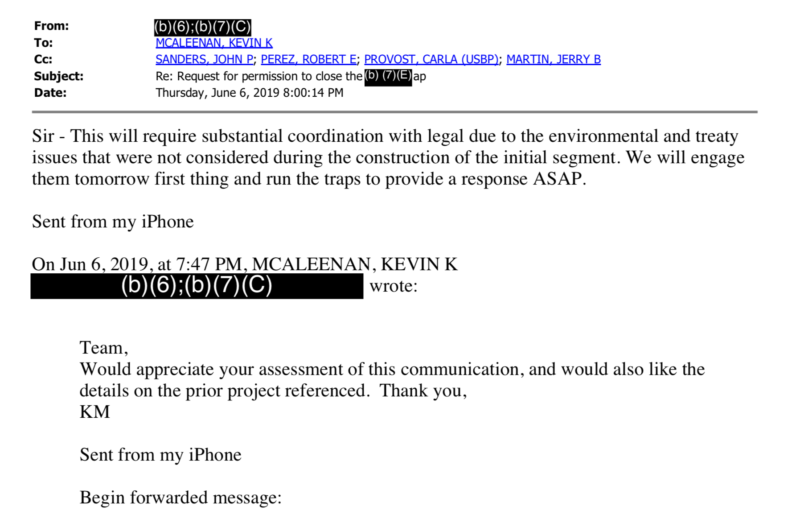
McAleenan passed along the letter to several CBP officials, asking them for an “assessment of this communication” as well as “the details on the prior project referenced.” Within a few days, background materials — assembled with the help of DHS counsel, engineers and environmental experts — were prepared for McAleenan, covering both a fence construction project the group had already undertaken near the border, as well the new project We Build The Wall was now proposing. (The five-page briefing paper itself was redacted.)
On July 8th and 9th, DHS conducted a visit of the border barrier We Build the Wall had already built and concluded that it has had a “positive operational impact,” according to a separate analysis of We Build The Wall’s work.
On the afternoon of July 9, Kobach was informed via email that U.S. Customs and Border Protection was sending him a letter from Deputy Commissioner Perez. Perez’s letter itself was not among the documents TPM obtained, but it led to an offer for an in-person meeting, which was then scheduled for August 27.
In the weeks leading up to the meeting, Kobach apparently had multiple phone calls with Perez, according to the documents, as well as email exchanges with Brian Martin, then CBP’s directorate chief of strategic planning and analysis.
‘No Issue With The Donation’
Per the DHS document summarizing the August 27 meeting, We Build The Wall’s “challenges” with GoFundMe were among the topics discussed.
Indeed, the GoFundMe account that We Build The Wall founder Brian Kolfage had set up in Dec. 2018 was suspended by the platform that same month. According to the grand jury’s indictment, GoFundMe warned Kolfage that it would return the more than $20,000 his We Build The Wall fundraising page had already attracted unless a “legitimate” non-profit organization was identified as the recipient of the fundraising. Kolfage, working with Bannon and others, then launched We Build The Wall as a non-profit.
That was just the beginning of the sketchy fundraising tactics that culminated in the conduct that prosecutors now say was illegal.
The fraud scheme alleged by prosecutors began in January of 2019, weeks after when We Build The Wall was launched. Kolfage, along with several other leaders of the group, “misled” We Build The Wall donors about where the contributions were going, according to the charging papers, as they worked to “misappropriate” hundreds of thousands of dollars to their own personal use. (President Trump pardoned Bannon of the charges he faced for his involvement in the scheme, but the case against the other defendants is proceeding.)
One key accusation that prosecutors have made is that around Oct. 2019, the defendants were informed by a financial institution that they may be under investigation. At that point, Kolfage and another co-defendant began using encrypted messaging and took other steps, according to prosecutors, to conceal their scheme.
Kobach’s collaboration with the DHS continued even after his associates allegedly became aware of the probe. Kobach did not respond to TPM’s inquiry about the DHS documents and whether he was told by his associates that the group was under investigation. Kolfage makes only a brief appearance in the documents DHS produced this week, chiming in on an email exchange in Feb. 2020 to ask that he, as president of the We Build the Wall, be looped in on future correspondence,
With CBP having given Kobach instructions in August 2019 for submitting a border wall proposal, his group got to work that fall pulling together the paperwork. Kobach exchanged several emails with Martin that were also apparently supplemented by phone conversations, according to the documents.
The communications went beyond just the proposal materials themselves.
In late October, Martin, at Kobach’s request, provided Kobach with a point of contact to help We Build The Wall with an issue it was having with a railroad company that was apparently impeding its access to one of its construction sites. In mid-November, Martin was emailing with a lawyer for We Build The Wall (whose identity has been redacted) about a gate that the group had built and then turned over to the agency. During that exchange, Martin praised the “infrastructure system” on the site as “impactful.”
According to a document leaked to the Nation, a DHS counterterrorism official had done her own analysis in November of the construction work We Build The Wall was seeking to do on the border. She said that the construction contractor the group used (which was headed by a Republican donor) tended to inflate it abilities. Her memo raised several other complications that the offer to donate a portion of the wall posed: from the types of cameras We Build The Wall put on its fencing to doubts that the group would build its fencing high enough for DHS’ standards.
By the time the holidays rolled around, Martin was still counseling Kobach on drafting the submission, while Perez continued to inquire about the status of the offer to donate a section of wall.
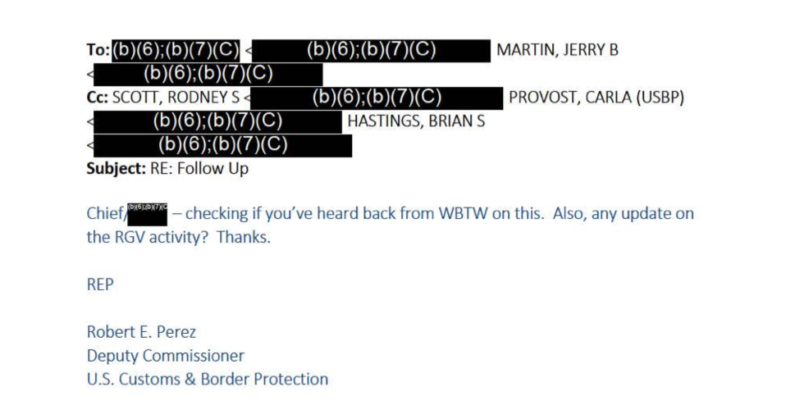
A version of the proposal submitted in early Jan. 2020 was ultimately deemed “incomplete” in an email from Martin to Perez. Kobach, meanwhile, asked to come visit Martin at DHS’ headquarters on January 27, after a meeting he had planned at the White House. (It’s unclear from the email whether that January DHS meeting happened.)
Kobach’s next attempt at submitting the border wall proposal seemed to go more smoothly. After an order from an official, whose name was redacted, for an “expeditious” review, several CBP officials weighed in.
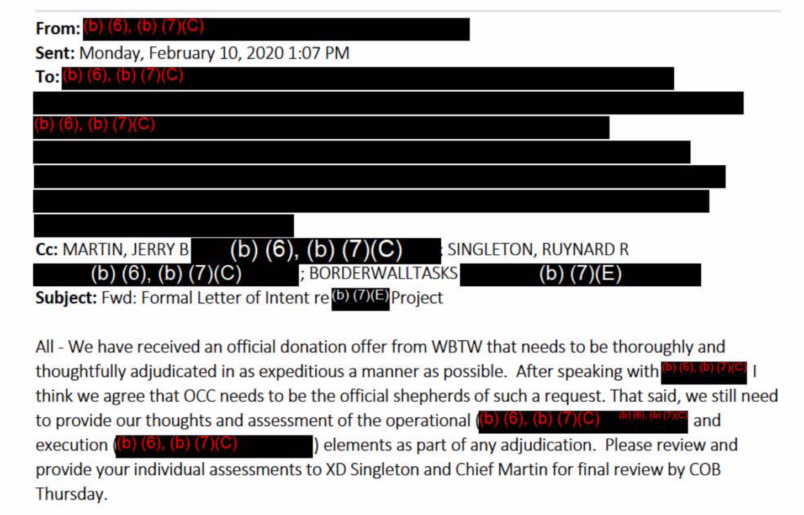
Martin said he had “no issue” with the package, as did another official, whose identity was also redacted.
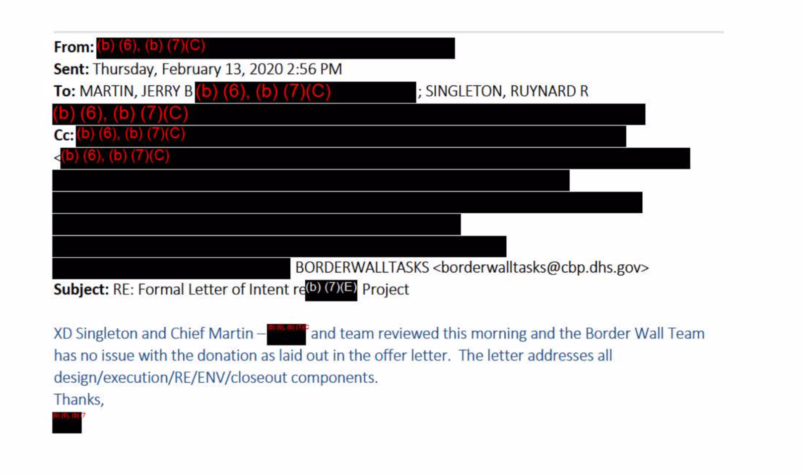
It’s unclear whether CBP gave We Build The Wall the final okay on the proposed donation. The communications produced in TPM’s FOIA end abruptly in mid-February and the CBP’s press shop did not answer by publication time TPM’s question about where the agency landed on We Build The Wall’s offer.
However, by that time, DHS was also preparing talking points on the We Build The Wall project, which were included in the FOIA production in a highly redacted form.
It also included a special note for “C1” — DHS parlance for CBP commissioner, who at the time was Mark Morgan. That portion of the memo was also redacted.
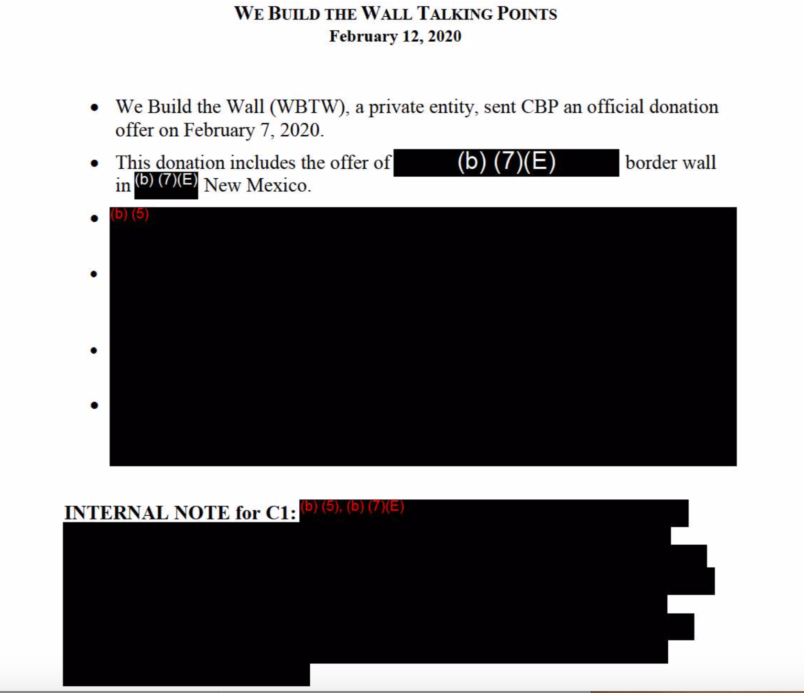
Josh Kovensky contributed reporting.


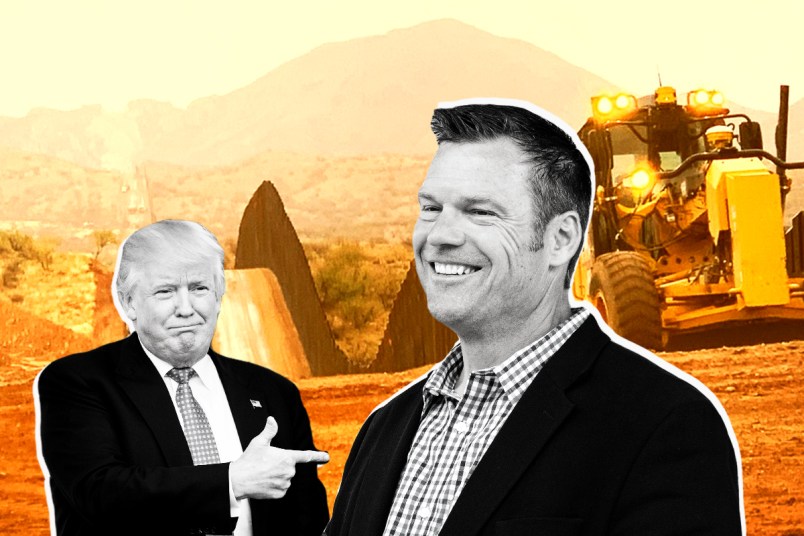




I think were gonna need to clone Merrick Garland…
I think looking into literally any Trump-era effort or project this closely would find any veneer of legitimacy crumbling like a rotten log. They really didn’t even try.
Trump’s DHS was a national security threat.
We the public may never learn the full extent of the dangers we faced these past 4 years.
FUCK!!!
Thanks for pulling the together TPM. This is the kind of reporting I subscribe for, not “republicans said stupid things on the tv today”.
There’s a lot of self-dealing, corruption and crime associated with the previous administration and we need to uncover all of it. We may not get the justice we thirst for against the former guy, but he was enabled all the way along and those enablers should be held to account. It doesn’t look like they’re very good at hiding their tracks.